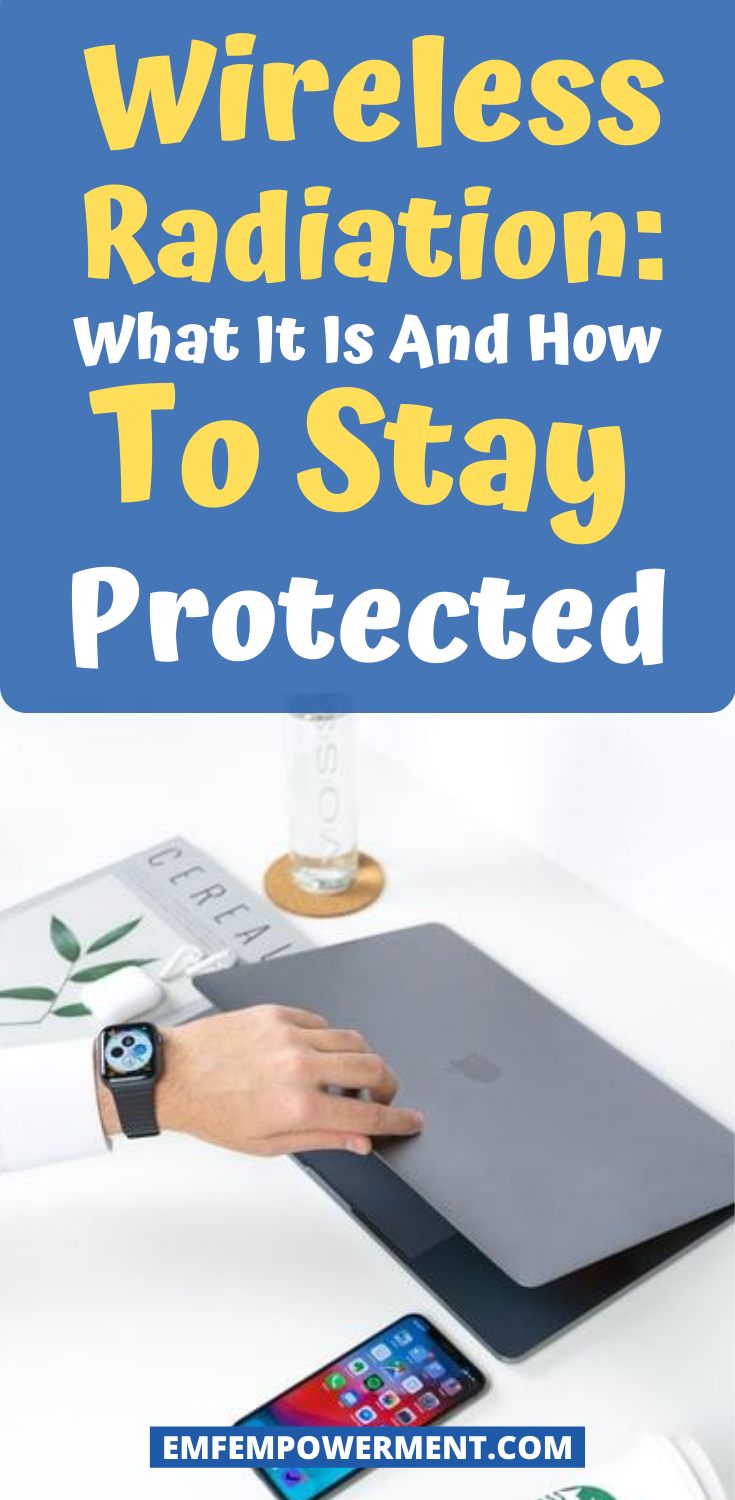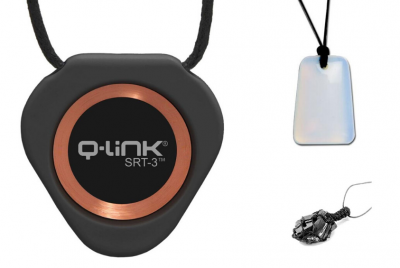When worn correctly, both Bluetooth and wired earbuds offer a lightweight and comfortable way to listen…
Wireless Radiation: What It Is And How To Stay Protected

*We may earn a commission for purchases made using our links. Please see our disclosure to learn more.
Wireless radiation surrounds us on a constant and daily basis. It’s present in our homes, our cars, and even outdoors. Should you be concerned?
The answer is yes. The presence of wireless radiation in our everyday lives should be a cause for concern. That being said, there is a great deal you can do to take charge and lower your exposure, thus minimizing any impact on your health.
What is wireless radiation?
Wireless radiation is the term for radiation produced by a wireless signal. It is more commonly known as radiofrequency (RF) electromagnetic field (EMF) radiation. WiFi signals, Bluetooth, smart appliances and gadgets, smart meters, and really anything else that uses radiofrequency waves to communicate with another device will result in the presence of RF-EMF radiation.
RF-EMF radiation isn’t the same as the radiation produced by an x-ray machine or nuclear bomb. It is on the non-ionizing side of the electromagnetic spectrum, meaning RF-EMF radiation lacks the energy necessary to split an atom. If you’re curious to learn more about radiation, you may want to head over to EMF Radiation 101.
Health risks of RF-EMF radiation
While wireless radiation may not be as notoriously dangerous as its ionizing counterparts, there are some risks associated with exposure. The World Health Organization’s International Association for Research on Cancer recognizes RF-EMF as “possibly carcinogenic to humans.” The primary reason for this designation is a study on rats and RF exposure. The rats were more likely to develop heart and brain tumors when exposed to so much wireless radiation per day.
RF-EMF radiation is also associated with male infertility due to problems with sperm motility and quantity. This may be because pockets are a common place to store a cell phone, but they are also in close proximity to reproductive organs. Miscarriages in women have also been linked to RF exposure during pregnancy.
In some highly-sensitive individuals, wireless radiation can induce a number of unpleasant side effects. These range from irritability, itchiness, skin rash, fatigue, headaches, and nausea. Often the symptoms are alleviated when the source of wireless radiation is removed.
History of wireless technology
The wireless technology that generates RF-EMF radiation may seem pretty modern, but it’s actually nothing new. In 1865, James Clerk Maxwell published “A Dynamical Theory of the Electromagnetic Field.” This was the first documented paper on electromagnetic fields, and it laid a groundwork for advancements in wireless communications.
Fast forward to the 1890s. Nikola Tesla, Ferdinand Braun, and Gugliemo Marconi were in different parts of the globe, all conducting research on wireless technology. Each had an important impact on the wireless industry.
Tesla’s goal was to create wireless electricity that would be broadcast via a transmitter. He passed away before he could accomplish what he set out to do, but his discoveries and the technology he created are still relevant today. Marconi, meanwhile, invented the first wireless telegraphy device, that used radio waves to send out Morse Code signals. He and Braun, who had done similar work using Tesla’s designs, both earned Nobel Prizes for their work in the wireless communications field.
Wireless technology has obviously grown by leaps and bounds since the 1890s. Soon radios rose in popularity, followed by Walkie Talkies in the 1940s. The first phone call from a cellular phone occurred in 1973, and while it took a few decades for their rise in popularity, modern cell phones are now everywhere.
In the early 1980s, the framework was laid for the creation of the internet. And in 1990, Tim Berners-Lee created the World Wide Web. As the internet’s reach grew and more and more homes gained access, it became necessary to find more ways to connect. A single dial-up modem could no longer keep up with the growing number of devices households had access to.
Enter wireless internet. In 1997, Dr. John O’Sullivan, an Australian radio-astronomer, worked with his colleagues to create what would become WiFi.
Measuring wireless radiation in your home
If you’re curious how much wireless radiation is present in your home, you can check your levels using an EMF meter. These are devices that read the ambient EMF radiation in the atmosphere. A good model should be able to detect electric and magnetic fields as well as RF-EMF radiation. One that we like to recommend on this site is the TriField TF2. For other options, check out EMF Meters For Any Budget.
With your EMF meter, take several readings in each room of your home. Try and take measurements from multiple positions throughout the room, and pay special attention to highly-trafficked areas. Bedrooms are of particular importance — be sure to check the EMF levels near anywhere your family sleeps.
Measuring your home’s levels should give you an idea of how best to reduce your exposure. If you’ve found that near the wireless router the levels spike up, for example, you may want to either install a WiFi router guard or switch to wired internet. Or if you discover that one part of your living room has higher levels than the rest, you may want to re-arrange the furniture away from that area.
Keeping yourself safe
- Follow whole-house safety tips for EMF protection. As you now know, there are many devices in your home that create wireless radiation. Whole-house protection refers to the many steps you can take to reduce this radiation, and it includes actions such as switching to wired internet, installing incandescent light bulbs, and staying away from smart appliances. For more on whole-house protection, see our guide.
- Don’t carry your cell phone in your pocket. As we noted earlier, when you carry your cell phone in your pocket you are placing wireless radiation near sensitive reproductive organs. For that reason, opt-out of carrying your phone in your pocket or anywhere on your person, really.
- Use a protective cell phone case. EMF protection cases for your cell phone reduce the amount of radiation you are exposed to from the back of the device. Many of them cut down on the radiation produced by about 99%, although you still need to be mindful when you are actually using your phone. One great case is DefenderShield’s Anti-EMF Protection Case, which advertises itself as being “virtually 100%” EMF-proof. For other cases, check out our guide to Cell Phone Radiation.
- Install an EMF bed canopy in your bedroom. EMF bed canopies are especially helpful if you must keep your cell phone on and near you at night. Placing the phone on the other side of the canopy will help protect you from its wireless radiation, providing you with an EMF-free night’s rest.
- If your home has a smart meter, purchase a cover and interior shielding. Smart meters generate a huge amount of wireless radiation as they constantly seek to communicate with a base station. To cut down on this, consider installing a smart meter cover over the meter itself. This cover keeps radiation from going out while still allowing a signal to pass through. To protect the interior wall that faces your smart meter, put down two layers of EMF paint, or hang a protective barrier. For more information, see our guide to smart meter radiation.
Final thoughts
Wireless radiation is inescapable, but that doesn’t mean you have to resign yourself to its risks. There are many things you can do to protect yourself and lower your family’s exposure. 



